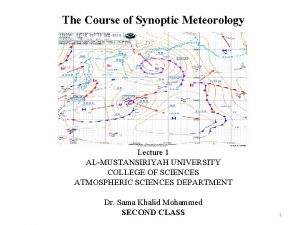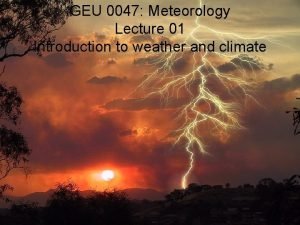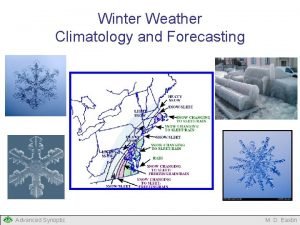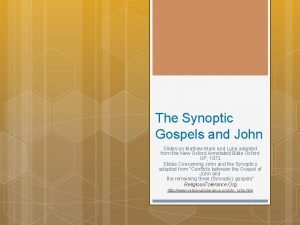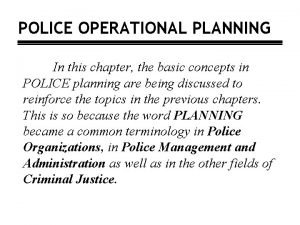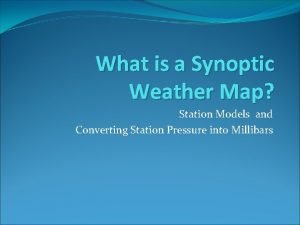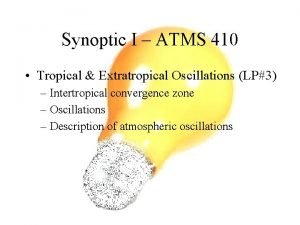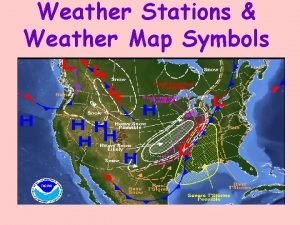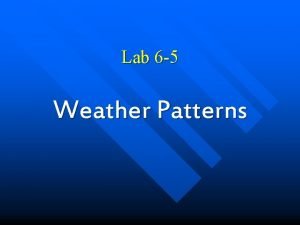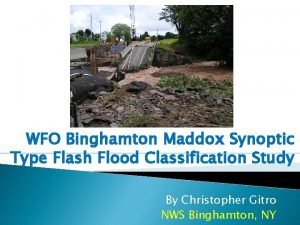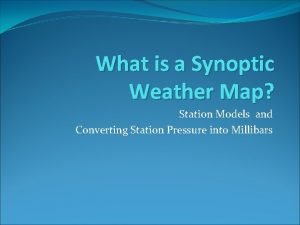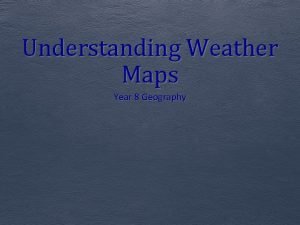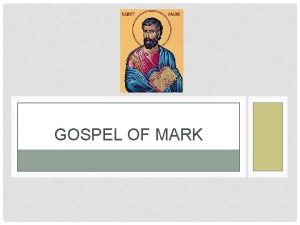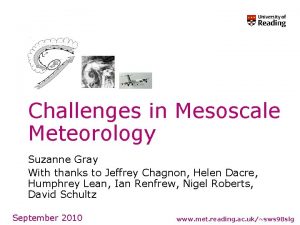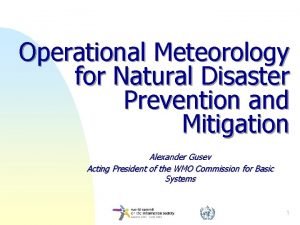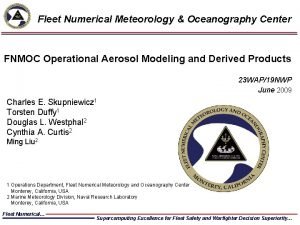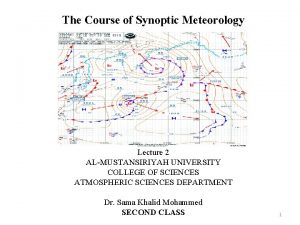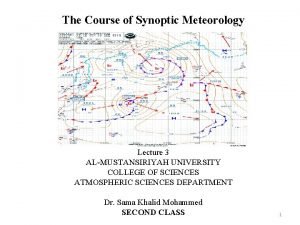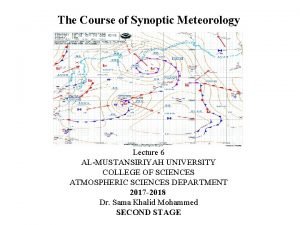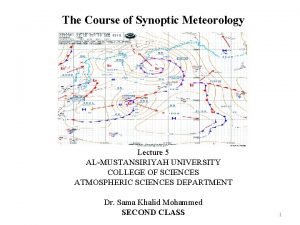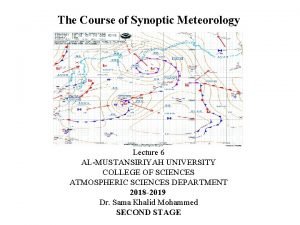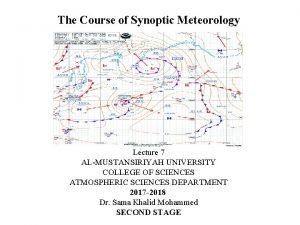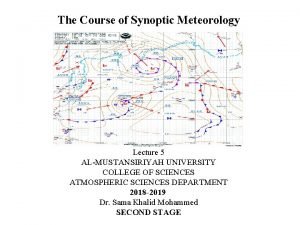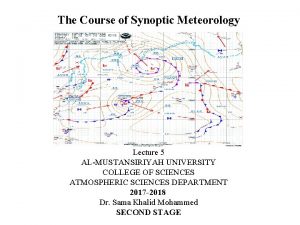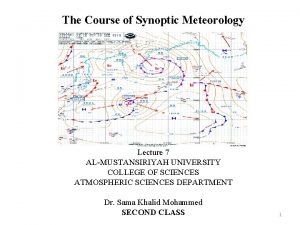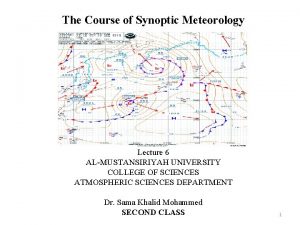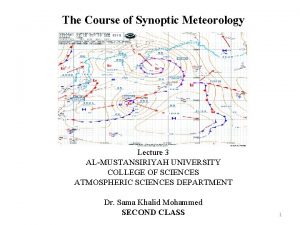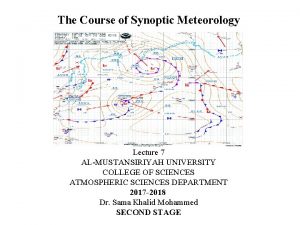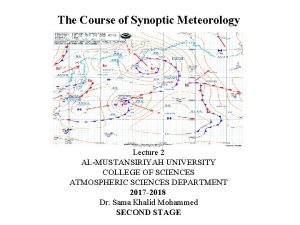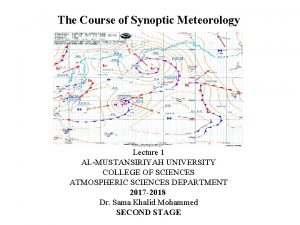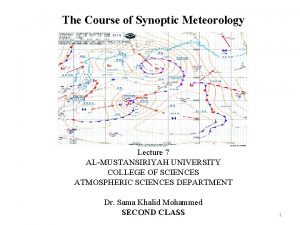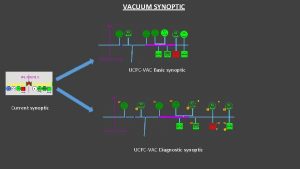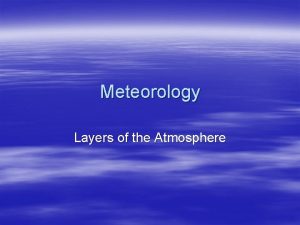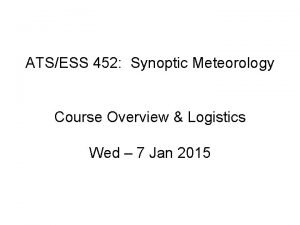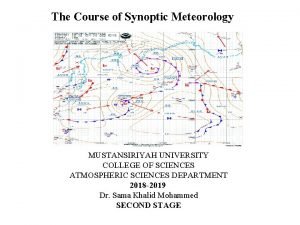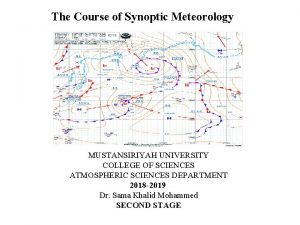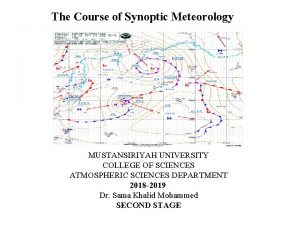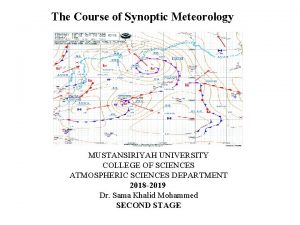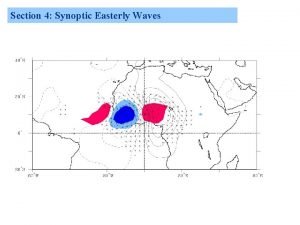The Course of Synoptic Meteorology Lecture 1 ALMUSTANSIRIYAH



























- Slides: 27

The Course of Synoptic Meteorology Lecture 1 AL-MUSTANSIRIYAH UNIVERSITY COLLEGE OF SCIENCES ATMOSPHERIC SCIENCES DEPARTMENT Dr. Sama Khalid Mohammed SECOND CLASS 1

2

What are covered in this course? Weather Maps Surface maps, upper air maps, Observation times and collection, codes, surface synoptic codes, upper air codes, Marian and ship codes, satellite codes, radar codes. Representing Weather Phenomena on maps International model of weather map, cloud cover, wind speed and direction, temperature and dew point, present and past weathers, cloud type, amount, and height, amount of precipitation and previous period of precipitation, pressure, pressure tendency and sea level pressure. Contouring Weather Maps Contour lines and types, pressure analysis, Low and high pressure systems and their extensions, discontinuity, waves. Air Masses Types of air masses, formation methods of air masses, prevailing air masses, thermal inversions. 3

Fronts Introduction, warm front circulation, cold front circulation, horizontal and vertical structure of cold front, frontal theory, rule of locating fronts on weather maps. Life Time of Frontal Low Classical model, Structure of open wave, subtropical and polar jet streams. 4

Introduction 1. 1 Scales of Atmospheric Motion Meteorologists arrange circulations according to their size, start from tiny gusts to giant storms which is called the scales of motion. Consider smoke rising into the otherwise clean air from a chimney in the industrial section of a large city (see Fig. 1. 1 a). Within the smoke, small chaotic motion (tiny eddies) cause it to tumble and turn. These eddies constitute the smallest scale of motion ”The Microscale”, in which eddies have diameters of a few meters or less and they form by convection or by the wind blowing past obstructions and are usually shortlived, lasting only a few minutes at best. 5

As the smoke rises, it drifts toward the center of town. Here the smoke rises even higher and is carried back toward the industrial section. This circulation of city air constitutes the next larger scale “The mesoscale” (meaning middle scale). Typical mesoscale winds range from a few kilometers to about a hundred kilometers in diameter. Generally, they last longer than microscale motions, often many minutes, hours, or in some cases as long as a day. Mesoscale circulations include local winds (which form along shorelines and mountains), as well as thunderstorms, tornadoes, and small tropical storms. 6

When we look for the smokestack on a surface weather map (Fig. 1. 1 c), neither the smokestack nor the circulation of city air shows up. All that we see are the circulations around high and low pressure areas— the cyclones and anticyclones of the middle latitude. We are now looking at the synoptic scale, or weather map scale. Circulations of this magnitude dominate regions of hundreds to even thousands of square kilometres and, although the life spans of these features vary, they typically last for days and sometimes weeks. The largest wind patterns are seen at the planetary (global) scale. Here, we have wind patterns ranging over the entire earth. 7

Scales of Atmospheric Motion (Table 1. 1 summarizes the various scales of motion and their average life span. ) 8

1. 2 Synoptic Meteorology Synoptic: from “Synoptikos”, a Greek word, means “presenting a summary of the principal parts or a general view of the whole. ” or “view together” For us, it means that you take everything you learned from physical meteorology, dynamic meteorology, remote sensing, and put them together. Synoptic meteorology traditionally involves the study of weather systems, such as extra-tropical high and low pressure systems, jet streams and associated waves, and fronts. Synoptic Scale Definition: a scale at which atmospheric phenomena at horizontal dimensions that are much larger than their vertical dimensions. It is the typical weather map scale that shows features such as high- and low pressure areas and fronts over a distance spanning a continent. Also called the cyclonic scale. 1. 3 Global Observing System (GOS) and its components The WMO (GOS) comprised of operationally reliable surface- and space-based subsystems. 9

Its components of : • Surface observations • Upper-air observations • Marine observations • Aircraft-based observations • Satellite observations • Weather Radar observations • Other observation platforms For more information, visit this website http: //www. wmo. int/pages/prog/www/OSY/Gos-components. html 1. 4 Types of Observations Current weather information for a location includes observations recorded by: 1. Humans through visual observation. 2. Automated systems such as sensors at airports. 3. A combination of human and automated data gathering. 10

Once collected, the observations from both human and automated data sources are reported using symbols, codes, and written text. They can then be plotted on maps for a view of conditions and patterns across various spatial scales. Many routine observations are collected using weather balloons, which rely on both a human observer and an automatic-reporting technology. Once or twice per day, observers at locations around the world release large balloons to carry lightweight sensors upward through the atmosphere. These sensors, called radiosondes, can sometimes be launched more frequently during severe weather or focused observation campaigns. The resulting radiosonde observations (RAOBs) provide vertical profiles of temperature, moisture, and winds in the atmosphere. Radiosondes are launched from over 800 locations around the world, represented by the yellow dots on the map. 11

One of the most commonly reported weather observations is the METAR is not an acronym. Rather, it refers to the format for standardized weather reports used primarily by meteorologists and pilots. METARs are hourly observations taken at numerous airports or official observing stations around the globe, providing fairly good coverage over land areas. Pilots worldwide depend on METARs because these observations represent the most current conditions for an area. If conditions change significantly before the next METAR, a special report (SPECI) will be issued. METARs and SPECIs use a particular format for presenting weather information. 12

At six hour intervals, a more comprehensive set of weather observations called a synoptic observation is reported manually by an observer or transmitted directly from an automated observing system. These synoptic observations include: Precipitation, temperature, cloud base and type, visibility, wind, barometric pressure, climate, sea conditions Synoptic observations are reported in SYNOP, or SHIP, format. This format accommodates more information than the METAR, including additional codes to help abbreviate the information. METARs are likely to be the most common observation format used by meteorological technicians and forecasters, but familiarity with SYNOP, SHIP, and CLIMAT formats is also useful. A land-based meteorological station transmits a CLIMAT report typically once per month. The CLIMAT format is used to summarize the average values computed from daily observations and typically includes monthly mean temperature and pressure, mean daily maximum and minimum temperatures for the month, and monthly totals for precipitation and sunshine. 13

1. 5 Universal Time To ensure that the observations are taken and reported at the correct times, and to ensure that the radiosondes are launched simultaneously, a common time system is required. This provides a view of atmospheric conditions for broad areas of the world. To work within a common time system, weather communities use a 24 -hour clock based on the 0° longitude meridian, known as the Greenwich Meridian. On this clock, 00: 00 UTC is 12: 00 a. m. local Greenwich time and the hours and minutes increment through the course of the day so that 23: 59 UTC is 11: 59 p. m. local Greenwich time. Before 1972, this universal clock was referred to as Greenwich Mean Time (GMT), but is now known as Universal Time Coordinated (UTC) or Coordinated Universal Time. It is also sometimes referred to as Zulu Time or Z time. 14

15

UTC is used to specify the set times that observations are taken and reported worldwide: METARs: hourly, with SPECIs as conditions change Balloon-borne radiosondes: 00 UTC and 12: 00 UTC Synoptic observations: 00 UTC, 06: 00 UTC, 12: 00 UTC, 18: 00 UTC Working with UTC takes some practice. You can determine your local time by adding or subtracting a set number of hours from UTC. The number of hours you add or subtract corresponds to the number of time zones you would cross if you were to travel from Greenwich, England to your local location. You will need to consider if you cross the international date line (shown in black toward the right edge of the image) or if your location has special time considerations such as daylight saving time, which might require that you add or subtract an additional hour depending on the time of year. How and when these special circumstances affect your local time will be specific to your location. Let's look at an example. 16

If you are located in Manila in the Philippines, what local time would correspond to 09: 00 UTC? The Philippines are located in the South China Sea, directly north of Indonesia. From the map, Manila is +8 hours from UTC, so eight hours ahead of UTC or Greenwich Mean Time. To find the local time, add the UTC conversion to the current time: Local time = UTC + offset PHT (Philippine Standard Time) = UTC + 8 PHT = 09: 00 UTC + 8 hours (UTC conversion) = 17: 00 hours The local time is 17: 00, or 5: 00 p. m. 1. 6 Overview of Weather Maps and Symbols Weather affects marine and aviation operations as well as activities across other domains. Forecasters and consumers of weather information need a way to be able to anticipate how conditions are changing and what situations might be expected in near-term or longer time frames. To help find those answers, weather maps or charts provide a view of conditions and patterns across larger spatial scales. Mapping the changes in pressure, temperature, winds, and other weather parameters across areas provides information about weather systems and how 17 they move or evolve.

The ability to accurately read and interpret these charts is integral to the weather forecasting process. 18

1. 6. 1 The Weather Station Model Oftentimes, weather maps will display observation information using a "station model" format. Station models are a way to show information in a small space without words. Instead, specific symbols are used to represent cloud cover, wind speed, and other meteorological variables. Here is a guide to decoding a simplified station model. 19

• Temperature • Measure of the amount of heat • 28⁰C • Visibility • How far you can see • 1 km • Present weather • Any sort of condensation or precipitation • Snow 28 1 * 20

21

• Dew point • Temperature at which condensation happens • 27⁰C 27 • Wind speed • How fast wind is blowing • 15 knots In the northern hemisphere, the lines and flags are on the clockwise side of the barb. The wind barb is oriented 45 degrees, indicating a wind from the northeast. 22

• Wind direction • Which way the wind is coming from • Coming from the southwest 23

• Cloud cover • Amount of clouds in the sky • 75% 24

• Pressure • How compact air molecules are • 1019. 6 mb Rule: greater than 500, put a 9 in front; less than 500 put a 10 in front • Pressure trend • The pattern of pressure in past 3 hours • Has gone up (+) 1. 9 mb (19) in the past 3 hours and will continue to rise (/) 196 +19/ 25

Some parameters (present or current weather, sky cover, winds) are represented on a station model by symbols. These symbols include wind barbs, which use lines and flags to represent wind speeds. These lines and flags are oriented in the opposite direction in the Southern Hemisphere compared to the Northern Hemisphere. Other weather parameters included in the station model are represented numerically. Pressure is abbreviated as a three-number code, with the last digit representing the decimal. If the first number of the pressure reported on the station model is less than 500 the sea level pressure is the number provided by placing a "10" in front of the three-number code and putting the decimal point in front of the last digit (e. g. , 415 corresponds to 1041. 5 mb). If the first number on the model is more than 500, the sea level pressure is the number provided by placing a "9" in front of the three-number code (697 corresponds to a sea level pressure of 969. 7 mb). Likewise, 119 denotes a sea level pressure of 1011. 9 h. Pa (1011. 9 mb) and 873 denotes a pressure of 987. 3 h. Pa (987. 3 mb). 26

There are no rules to address a three-number code starting with the number 500 because sea level pressures should not fall outside the range from 960 -1049 h. Pa (960 -1049 mb). The pressure trend reports the three-hour pressure change in tenths of millibars. The value can be expressed as either one or two digits. A value of -18 for the pressure trend means that the pressure has fallen 1. 8 h. Pa (or 1. 8 mb). A pressure decrease of 0. 5 h. Pa (or 0. 5 mb) can be written as -5 or -05 on the station model. 27
 Synoptic meteorology course
Synoptic meteorology course Keeling curve
Keeling curve 01:640:244 lecture notes - lecture 15: plat, idah, farad
01:640:244 lecture notes - lecture 15: plat, idah, farad Synoptic
Synoptic Synoptic gospels
Synoptic gospels Thermal wind
Thermal wind Police operational planning examples
Police operational planning examples Bogers synoptic key
Bogers synoptic key Synoptic weather station model
Synoptic weather station model Card repertory model
Card repertory model Synoptic
Synoptic Sunoptic gospels
Sunoptic gospels Wjec criminology past papers unit 4
Wjec criminology past papers unit 4 Ship synoptic code
Ship synoptic code Synoptic gospels
Synoptic gospels Weather station symbol
Weather station symbol Lab 6-5 weather patterns answer key
Lab 6-5 weather patterns answer key Maddox synoptic pattern
Maddox synoptic pattern Synoptic weather station model
Synoptic weather station model List the synoptic gospels
List the synoptic gospels Synoptic chart example
Synoptic chart example Synoptic gospels comparison chart pdf
Synoptic gospels comparison chart pdf Course interne course externe
Course interne course externe Half brick wall
Half brick wall Course title and course number
Course title and course number Meteorology
Meteorology Meteorology
Meteorology Fnmoc
Fnmoc
